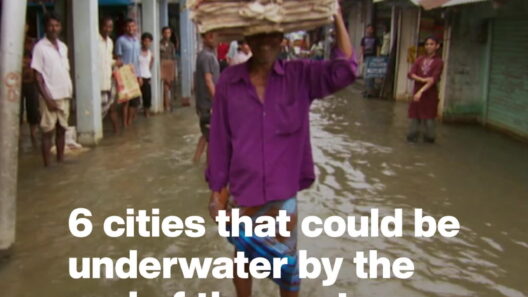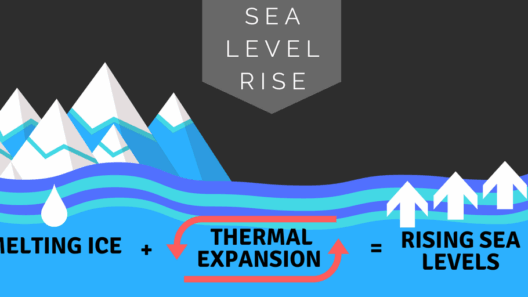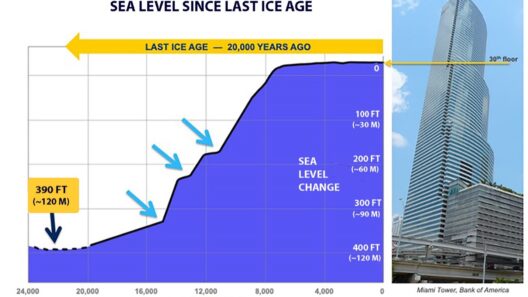Understanding the Menacing Tide: The Science of Rising Sea Levels
The phenomenon of rising sea levels has transitioned from a distant concern to a pressing reality that beckons for urgent attention. As glaciers and polar ice sheets melt at an unprecedented rate, and as ocean waters expand due to heating, coastlines around the globe are shifting dramatically. This inexorable rise not only poses significant threats to human habitation but also catalyzes profound changes in interdependent ecosystems. By examining these multifaceted impacts, we can glean deeper insights into the cascading effects that sea level rise has on both our environment and our future.
The Encroaching Waters: Impacts on Coastal Infrastructure
Coastal communities are on the frontline of rising sea levels, and the repercussions are already far-reaching. With inundation becoming more frequent, critical infrastructure—including roads, bridges, and sewage systems—faces severe jeopardy. Consider how essential these structures are for daily human activities and economic stability. As they succumb to the relentless advance of sea waters, not only does the financial burden for repairs escalate, but the health and safety of residents are also compromised.
Moreover, the potential for increased flooding exacerbates the problems of urban drainage systems, which are typically ill-equipped to handle heavy inundation. Storm surges, driven by climate change-induced weather events, spiral into devastating floods that can linger for days or even weeks. These episodes illustrate the harsher reality: sea level rise isn’t just a future concern; it is affecting thousands of lives and livelihoods today.
Along the Atlantic coast, for instance, cities like Miami have already begun implementing adaptive strategies, including sea walls and improved drainage systems, to shield against the rising tide. Unfortunately, such measures often come with substantial economic implications, particularly for low-income communities that may lack the resources to safeguard their homes.
Displacement Dynamics: A Humanitarian Crisis Looms
As coastlines continue their inexorable retreat, human displacement emerges as a dire consequence. Coastal areas, which have traditionally housed millions of people, are undergoing transformation into uninhabitable zones. This exodus signifies a growing humanitarian crisis: climate refugees seeking sanctuary inland in search of safety, stability, and sustenance.
This phenomenon is not limited to any singular region or community. Globally, countries such as Bangladesh face annual monsoons that exacerbate flooding, displacing entire populations due to rising tides and soil salinization. The challenge is compounded by socio-economic disparities; those who are already vulnerable suffer the most from this upheaval.
Furthermore, this displacement brings forth tangible implications for urban planning, resource management, and social cohesion. Local governments increasingly grapple with the influx of displaced populations, which can strain infrastructure, social services, and housing markets within host communities. The shifting demographic landscape demands innovative governance strategies and equitable resource distribution, something that many regions are unprepared to address efficiently.
Vanishing Habitats: Ecological Consequences of Sea Level Rise
The relentless march of rising sea levels plunges ecosystems into turmoil. Coastal wetlands, estuaries, and mangroves—critical buffers that not only protect inland areas from storm surges but also serve as nursery habitats for countless marine species—are at grave risk. As salinity levels increase due to flooding, many sensitive habitats become inhospitable to native flora and fauna.
Take, for example, the intricate ecosystems of mangrove swamps, often referred to as “nature’s guardians.” These biologically rich environments not only sequester carbon but also provide habitat for diverse species. Their gradual submersion poses a dire threat to biodiversity. Species that cannot migrate or adapt swiftly to changing salinity levels or altered water temperatures are likely to face population declines or even extinction. This disintegration of biodiversity has far-reaching effects, altering food webs and local fisheries alike, stressing human communities that depend on these ecosystems for sustenance and economic activity.
Strategies for Resilience: Adaptive Solutions for a Shifting Landscape
Addressing the crises induced by rising sea levels requires a comprehensive array of adaptive strategies that meld science, policy, and community engagement. Innovations in natural and engineered solutions offer promising pathways to bolster resilience. For example, the restoration of coastal ecosystems such as wetlands and mangroves can not only act as barriers against storm surges but also revitalize local biodiversity.
In addition, proactive urban planning that emphasizes sustainable development is paramount. This includes creating flexible zoning laws, promoting public green spaces to absorb runoff, and investing in climate-resilient infrastructure. Integration of community resources, such as education and local stewardship programs, can engender a culture of resilience among residents, ensuring collective action in the face of adversity.
Furthermore, the role of policy cannot be overstated. International cooperation is essential in combating climate change and its impacts. Countries need robust frameworks for climate adaptation funding and knowledge sharing. Initiatives that empower vulnerable communities on the frontlines of climate change can cultivate hope and resilience amidst daunting challenges.
Conclusion: The Imperative for Collective Action
The manifestations of rising sea levels are a clarion call for collective action. As coastlines recede and ecosystems falter, the ramifications will reverberate beyond geographic borders. The interplay between humanity and nature is delicate and demands a unified response that recognizes our interconnectedness. Ensuring a sustainable future amidst the rising tide necessitates proactive thinking, resilient adaptations, and a commitment to nurturing our planet for generations to come.







